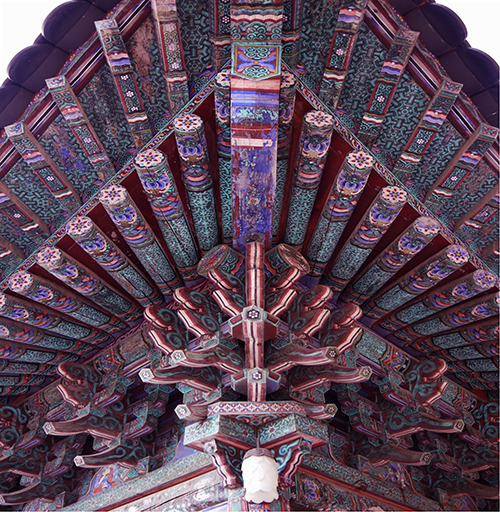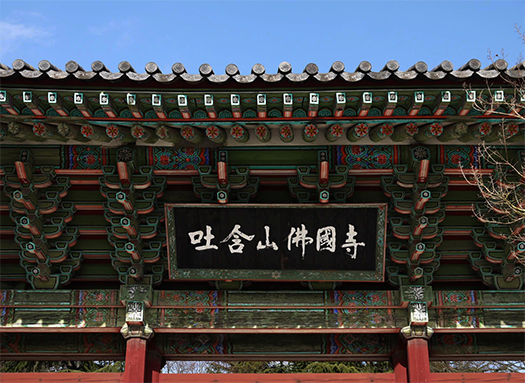

写真は韓国旅行での慶州・仏国寺。
仏国寺は韓国仏教界最大勢力・曹渓宗の寺院。吐含山のふもとにある。
1995年「石窟庵と仏国寺」としてユネスコ世界遺産に登録された。
751年当時新羅の宰相だった金大城により建立がはじまったとされる。
日本の法隆寺の創建は607年でこの751年当時は翌年に東大寺大仏の開眼。
この新羅からは王子を首席とする祝賀国歌使節団が来朝している。
国際政治情勢としては、新羅と国境を接する渤海国と新羅で緊張状態があって、
日本との関係が重視されていたような情勢だったとされる。
また754年には鑑真が日本にやってきて仏教のさらなる深化が進んだ時期。
749年には奥州での産金があり大仏に鍍金された。
先日触れた「天平のパンデミック」は735-737年。
ということで国際政治動向と仏教の動き、経済の動きが活発に連動した時期。
仏教の動向が国際的にも非常に重要でセンシティブな事柄だった。
その後、李氏朝鮮の時代になると繰り返し仏教への弾圧があり
ほとんど廃寺同然の状況だったとされる。
仏国寺の案内には豊臣秀吉が1592年の文禄の役でこの寺を攻撃し破壊と韓国語表示。
日本統治時代の1924年4月から1925年8月迄の朝鮮総督府による再建工事によって
石壇・石廊を含む主要構造が修復されたともされる。
まことに半島国家として時代の国際状況がさまざまに反映する。
日本の法隆寺が朝鮮からの進軍で焼き討ちされたらと考えると
隣国人のこころにどう残っていくかは想像に難くないけれど、
一方で日本では自国の権力が法隆寺などを弾圧するというのは
信長の比叡山焼き討ちや平家による南都焼き討ちが想起される程度。
本能寺の例のように寺院というのは一種の「城郭」機能も果たすワケで
戦争に巻き込まれること自体はありうる事柄。
こうした歴史的推移を経てきている寺院建築なので
創建当時のデザインがどこまで反映されているかどうか、定かではない。
ただ世界遺産に登録されている時点で詳細な検討がされた結果と思える。
こうした威信的寺院建築では「組物」と呼ばれる部材が目を引く。
無限に続く涅槃の世界を表現しているように受け取ることができる。
東アジアの木造建築に共通する特徴と言われるそうです。
多雨の気候条件を考慮すれば、軒を建物の外側に大きく張り出させて
降雨をなるべく外側に落とす必要がある。
大きく軒を出させるにはそれを支える部材が必要になる。
日本の建物と中国と朝鮮それぞれの建物では屋根への感覚が若干違う。
「軒のソリ」が日本は比較的なだらかに落ちていくのに、
中国ではまるでひげの端を反り返らせるような好みが強い。
朝鮮・韓国でもこの傾向が強く見られる。
そしてそれを支える組物がその民族ごとに、あるいは作り手たちの感覚でか、
表現方法に違いがあるように思われる。
この仏国寺の組物ではカラー表現において独特と思える。
こういうデザイン表現を繰り返し感受することで
作用・反作用の相互反復で作る人・見る人の間でコミュニケーションが成立し
「民族性」もまた時間を掛けて涵養されていくものだと思う。
建築が持つ文化パワーの大きなポイントだと思えますね。
English version⬇
[East Asian Buddhist architecture and dougong “Nirvana” design expression]
The photo shows Bulguksa Temple in Gyeongju during a trip to Korea.
Bulguksa is a temple of the Jogye Order, the largest force in the Korean Buddhist world. It is located at the foot of Mt. Tohamsan.
In 1995, it was registered as a UNESCO World Heritage Site as “Seokguram Grotto and Buddhist Temple”.
It is said that the construction was started in 751 by Kim Daeseong, who was the Chancellor of Silla at that time.
Horyuji Temple in Japan was founded in 607, and in 751 the eyes of the Great Buddha of Todaiji Temple opened the following year.
From this Silla, a celebration national anthem delegation headed by the prince is coming to the morning.
As for the international political situation, there is tension between Balhae and Silla, which border Silla.
It is said that the situation was such that the relationship with Japan was emphasized.
In 754, Jianzhen came to Japan and Buddhism was further deepened.
In 749, there was gold produced in Oshu and it was plated by the Great Buddha.
The “Tenpyo Pandemic” I mentioned the other day is 735-737.
Therefore, it was a time when international political trends, Buddhist movements, and economic movements were actively linked.
The trend of Buddhism was a very important and sensitive matter internationally.
After that, in the Joseon era, there were repeated crackdowns on Buddhism.
It is said that the situation was almost like an abandoned temple.
Hideyoshi Toyotomi attacked this temple in the role of Bunroku in 1592 and displayed it in Korean as a guide to Bulguksa Temple.
By reconstruction work by the Government-General of Korea from April 1924 to August 1925 during the Japanese colonial era
It is said that the main structure including the stone platform and stone corridor was restored.
As a peninsula nation, the international situation of the times is reflected in various ways.
Imagine if Horyuji Temple in Japan was burned down by the march from Korea
It’s not hard to imagine how it will remain in the hearts of its neighbors,
On the other hand, in Japan, the fact that the power of one’s own country suppresses Horyuji Temple etc.
Nobunaga’s siege of Mount Hiei and Heike’s siege of Nara are reminiscent.
Like the example of Honnoji, a temple is a kind of “castle” function.
It is possible to get involved in a war.
Because it is a temple architecture that has undergone such a historical transition
It is uncertain how much the design at the time of its construction is reflected.
However, it seems that it was the result of detailed examination when it was registered as a World Heritage Site.
In such prestigious temple architecture, members called “kumimono” are eye-catching.
It can be received as if it represents the endless world of nirvana.
It is said to be a common feature of East Asian wooden architecture.
Considering the climatic conditions of heavy rain, the eaves are greatly extended to the outside of the building.
It is necessary to reduce the rainfall to the outside as much as possible.
In order to make the eaves large, the members that support them are required.
The feeling of the roof is slightly different between Japanese buildings and Chinese and Korean buildings.
“Eaves sled” is falling relatively gently in Japan
In China, there is a strong preference for the edges of the beard to bend.
This tendency is also strongly seen in Korea and South Korea.
And the structure that supports it is for each ethnic group or in the sense of the creators.
There seems to be a difference in the expression method.
This Bulguksa temple structure seems to be unique in color expression.
By repeatedly feeling this kind of design expression
Communication is established between the person who creates and the person who sees by the mutual repetition of action and reaction.
I think that “ethnicity” will also be cultivated over time.
I think it is a big point of the cultural power of architecture.
Posted on 9月 9th, 2021 by 三木 奎吾
Filed under: 「都市の快適」研究, 住宅マーケティング







コメントを投稿
「※誹謗中傷や、悪意のある書き込み、営利目的などのコメントを防ぐために、投稿された全てのコメントは一時的に保留されますのでご了承ください。」
You must be logged in to post a comment.